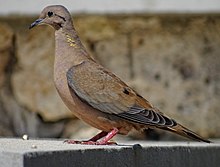Eared Dove
| Eared dove | |
|---|---|
 |
|
| In Oranjestad, Aruba | |
| Scientific classification | |
| Kingdom: | Animalia |
| Phylum: | Chordata |
| Class: | Aves |
| Order: | Columbiformes |
| Family: | Columbidae |
| Genus: | Zenaida |
| Species: | Z. auriculata |
| Binomial name | |
|
Zenaida auriculata (Des Murs, 1847) |
|
The eared dove (Zenaida auriculata) is a New World dove. It is a resident breeder throughout South America from Colombia to southern Argentina and Chile, and on the offshore islands from the Grenadines southwards. It may be a relatively recent colonist of Tobago and Trinidad. It appears to be partially migratory, its movements driven by food supplies.
It is a close relative of the North American mourning dove. With that species, the Socorro dove, and possibly the Galápagos dove it forms a superspecies. The latter two are insular offshoots, the Socorro birds from ancestral mourning doves, the Galápagos ones from more ancient stock.
The eared dove is 24 cm (9.4 in) long with a long wedge-shaped tail, and weighs normally about 112 g (4.0 oz). Adult males have mainly olive-brown upperpart plumage, with black spots on the wings. The head has a grey crown, black line behind the eye, and the blue-black on the lower ear coverts. These black markings give the species its English and specific name. The underparts are vinous, and the tail is tipped with cinnamon. The bill is black and the legs dark red.
The female is duller than the male, and immature birds are greyish-brown, very dull, with pale barring. The species' call is a deep soft oo-ah-oo.
The eared dove is common to abundant in savannahs and other open areas, including cultivation, and it readily adapts to human habitation, being seen on wires and telephone posts near towns in Trinidad and Venezuela, almost in all public spaces of large urban areas such as Bogotá, Colombia and feeding near beach resorts in Tobago.
Eared doves feed mainly on seed taken from the ground, but will take other items such as soaked bread. They can be agricultural pests. This is a gregarious bird when not feeding, and forms flocks especially at migration time or at communal roosts.
...
Wikipedia

